
Circle of Giacomo Caneva (Italian, 1813-1865)
Reclining goat in Rome, 1850s
Albumen print from a collodion negative
13.3 x 21.3 cm
The albumen print of Reclining goat in Rome, circle of Giacomo Caneva, 1850s, illustrates a threshold between the old and new in mid 19thcentury Rome. The goat’s resting place on the steps defies our idealistic vision of it wandering freely in its natural setting.
Inquire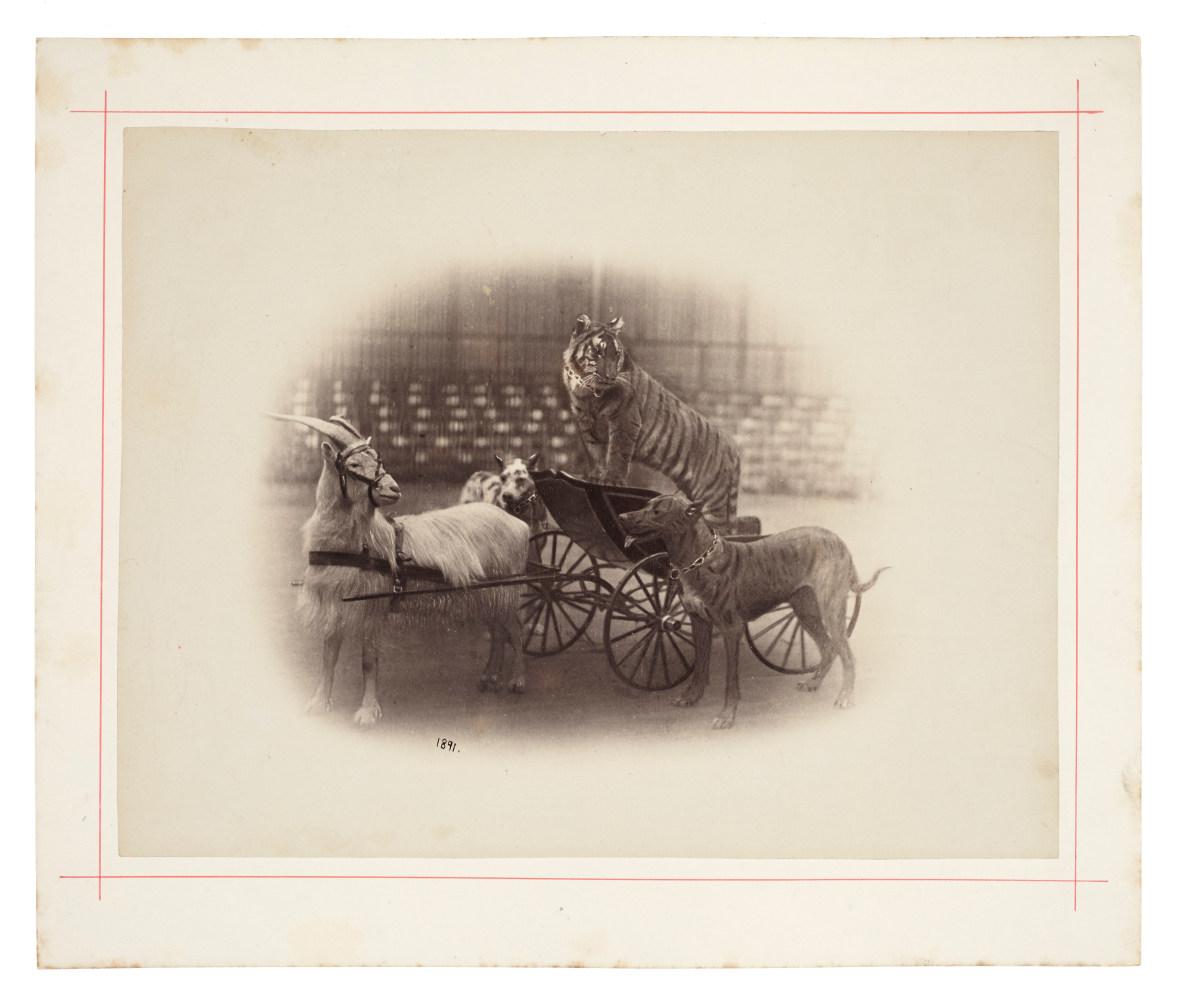
Peter Nissen (German)
Circus animals, goat pulling a tiger in a cart, with two dogs from Carl Hagenbeck's Zoologischer Circus, 1891
Albumen print
22.3 x 28.7 cm mounted on 28.4 x 33.8 cm card, ruled in red
Dated "1891" in the negative, and photographer's blindstamp. Stamped "Photographiesches-Atelier von Peter Nissen, Reeperbahn 28 Hamburg, St. Pauli" in ink on verso.
Wild animals tamed by zookeeper and photographer, this is a rare portfolio of live animal scenes from Carl Hagenbeck’s famous Zoological Circus. Hagenbeck (1844–1913) was an internationally known German animal dealer and trainer, whose fishmonger father had run a second business trading in exotic animals. Hagenbeck Junior accompanied explorers and hunters to bring back animals (and occasionally humans) from exotic locations to exhibit in Europe and the United States. He believed in controlling the animals by befriending them, emphasizing their intelligence and tractability over their ferocity. In 1889 he introduced a lion act in which, as a finale, three lions pulled him around the cage in a chariot. He trained animals to display and sell to circuses at the World’s Columbian Exposition in Chicago, Illinois in 1893, and the Louisiana Exhibition in St. Louis in 1904. He also supplied many zoos, as well as P. T. Barnum, and created the modern zoo with animal enclosures with moats rather than bars that were closer to the animals’ natural habitat. The Tierpark Hagenbeck still exists in Hamburg today.
This series of photographs tested Peter Nissen to the limit. In order to capture and tame the beasts in action for his audience he adopted every trick available to the analogue photographer of the 19th century. In some photographs the wild beasts are more appealingly fluffy than usual as they breathe and move during the lengthy exposures; in others whole animals or large portions of an animal have clearly been added to the negative by hand or montaged together in one print from multiple negatives. This portfolio is a wonderful, rare hybrid of the real and the surreal in zoological and photographic history.
Also included are two albumen prints of circus animals by Heinrich Johan Barby (Danish, 1858-1930), each 17.1 x 23.2 cm mounted on card with printed credit "H. J. Barby, Gl. Kongevej 178" on mount.
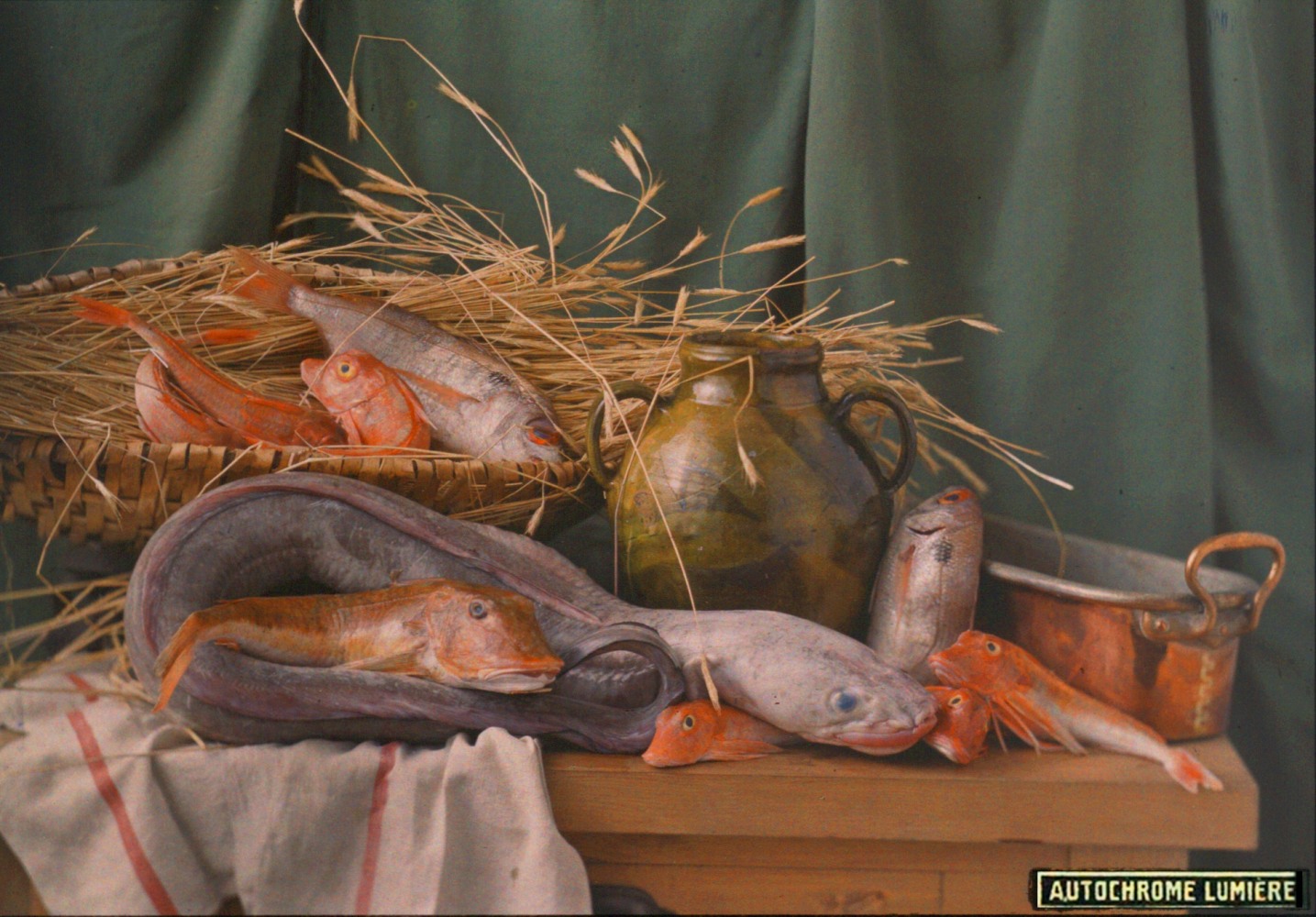
Lumière Brothers Studio (French)
Still life with fish, circa 1907
Autochrome
13.9 x 17.9 cm
"Autochromes Lumière" printed label
In the mid-19th century, painters revisited the still life work of the old masters. This revival enhanced the popularity of photographs modeled on the conventions of still-life painting. Autochromes, the first practical color photographic process, were patented in 1903 by Louis Lumière (1864-1948), the younger of the two brothers who figured prominently in the invention of the motion picture. Like daguerreotypes, each autochrome is a unique object.
Inquire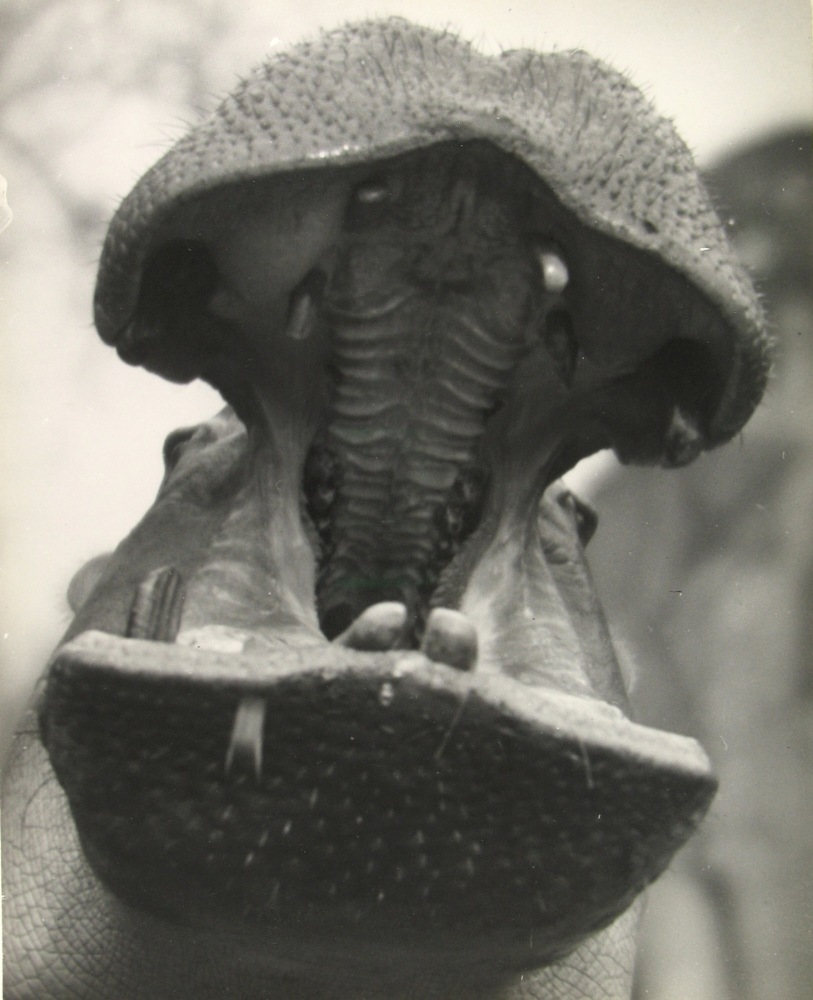
Martin Munkacsi (Hungarian, 1896-1963)
"Zoo in Budapest, Joe E. Brown" , 1920s
Gelatin silver print
33.8 x 27.0 cm
Inscribed "Zoo in Europe 1927-1933" in pencil on verso
Though best known for revolutionizing fashion photography with a naturalistic and energetic style, Martin Munkacsi (1896-1963) spent his early years photographing street life, sports, entertainers, and politics in Germany and Hungary in the late 1920s and ‘30s. His 1920s gelatin silver print of a roaring hippopotamus places the beast’s gaping jaws in full focus as if to swallow the viewer whole.
The verso of a press print of this image is titled and dated "1921" with the artist's Berlin and New York City studio stamps. An identification label on that print reads: "Taken with a speed graphic at 1/150th second at F:9 on Wellington Pan. film. A lens called 'Wessely half achrsmat' was used. It is a soft focus lens. Mr.Munkacsi took the picture because it amused him and reminded him of the movie star Joe E. Brown. He says that it has been more widely published than any of his prints."
Inquire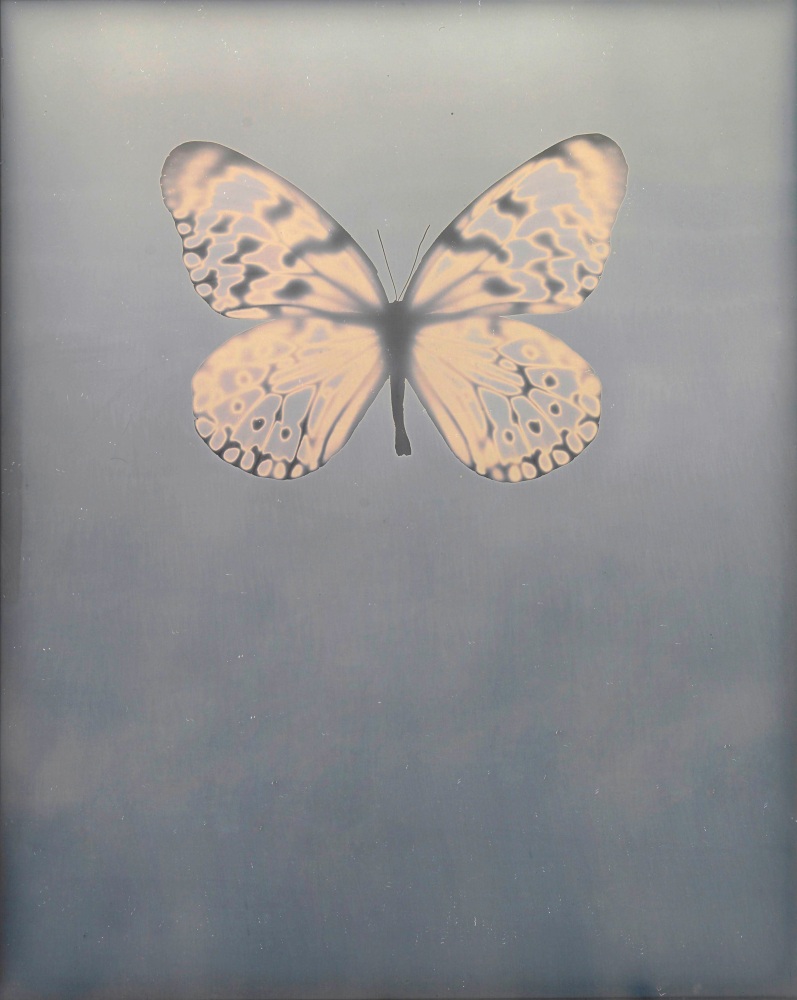
Adam Fuss (American, born in England, b. 1961)
Untitled "For Allegra", 2009
Daguerreotype photogram
25.4 x 20.3 cm framed to 35.5 x 30.0 cm
Signed and dated in blue ink on verso
In Untitled “For Allegra”, 2009, Adam Fuss returns to the most basic infrastructure of photography: objects, light-sensitive materials and light. Fuss’s work is distinctive for its contemporary reinterpretation of photography’s earliest techniques. His work includes photograms of butterflies, water droplets, smoke, flowers, birds and babies. His images engage processes that take place in the natural world and are transfigured into greater metaphors. His image of a butterfly, is remarkably both a photogram and a daguerreotype.
Inquire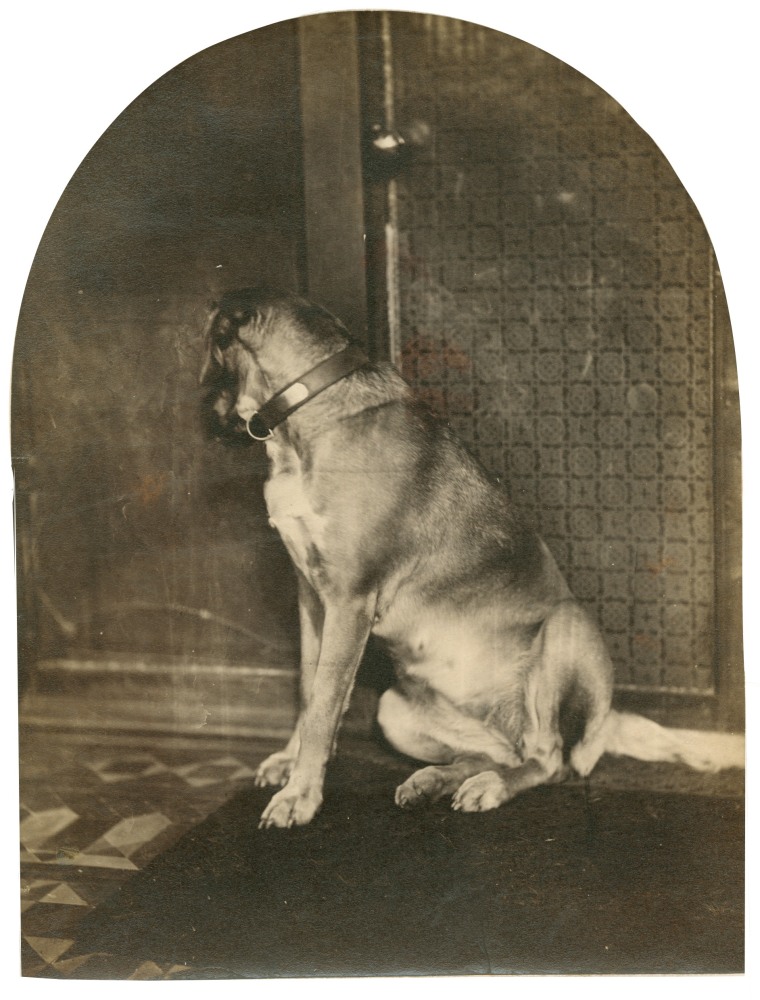
William James Stillman (American, 1828-1901)
Dog in Crete, 1865-1868
Albumen print from a wet collodion glass plate negative
20.2 x 15.4 cm, arched top, mounted on 35.0 x 28.7 cm paper
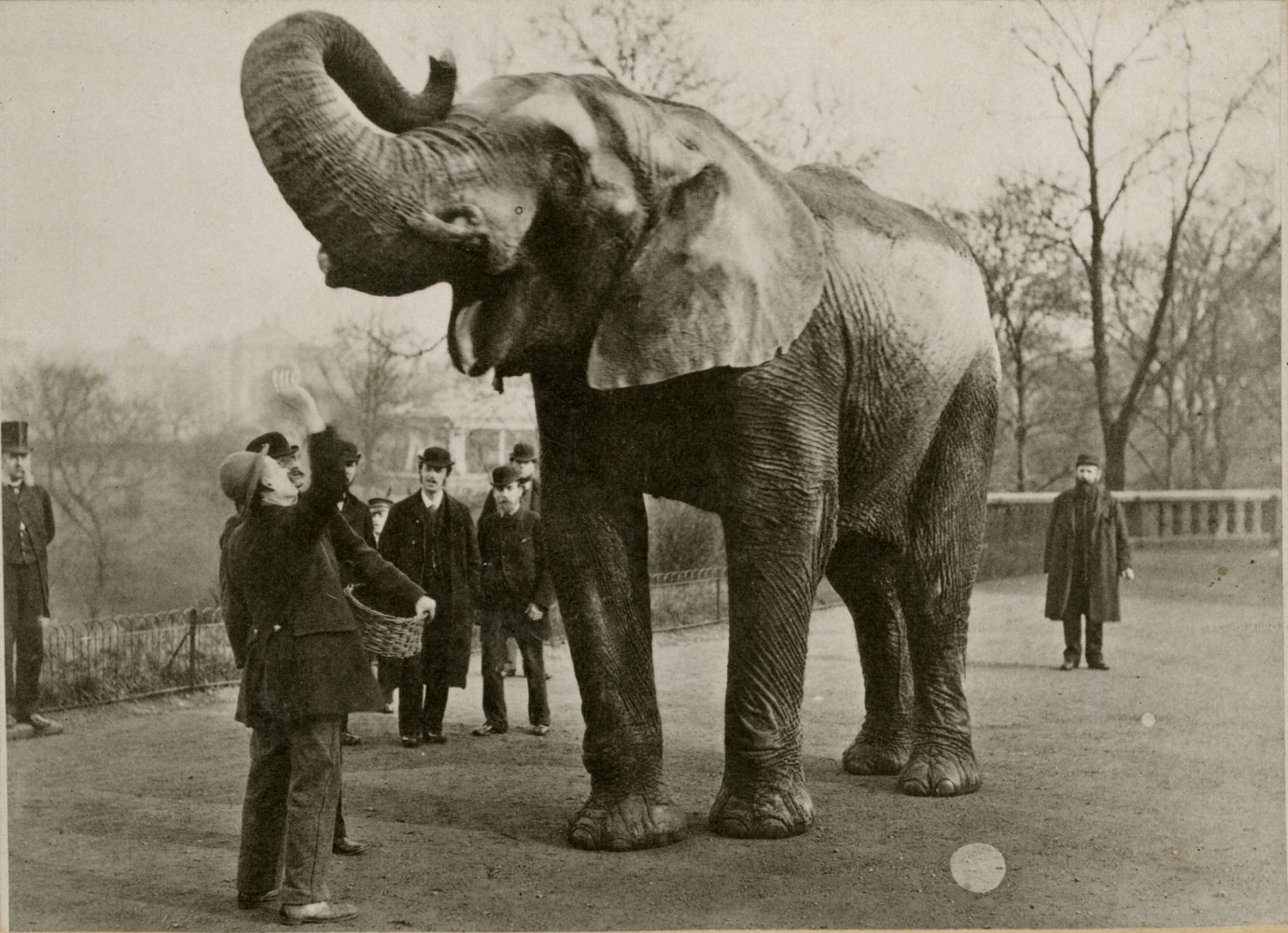
Edward Bierstadt (American, 1824-1906)
"Jumbo", 1882
Artotype, cabinet card
9.7 x 13.4 cm mounted on 10.5 x 14.7 cm card
Printed title on mount. Printed credits "Artotype / E. Bierstadt / 58 & 60 Reade St. / New York / This picture is printed in permanent ink, and will never fade" on mount verso.
Zoos made it possible to photograph unusual and exotic animals in captivity for the first time. But it is Jumbo the elephant, here featured in Edward Bierstadt’s 1882 artotype, who is the stuff of legend. Born in Sudan, exhibited in zoos in Germany, Paris, and London, Jumbo was purchased by P.T. Barnum in 1882 and brought to the U.S. where he was shown widely, enhancing Barnum’s fame. The Artotype is a form of collotype, a photomechanical printing process from a gelatin surface, that was available at Bierstadt's Artotype Atelier in New York.
Inquire
Circle of Giacomo Caneva (Italian, 1813-1865)
Reclining goat in Rome, 1850s
Albumen print from a collodion negative
13.3 x 21.3 cm
The albumen print of Reclining goat in Rome, circle of Giacomo Caneva, 1850s, illustrates a threshold between the old and new in mid 19thcentury Rome. The goat’s resting place on the steps defies our idealistic vision of it wandering freely in its natural setting.

Peter Nissen (German)
Circus animals, goat pulling a tiger in a cart, with two dogs from Carl Hagenbeck's Zoologischer Circus, 1891
Albumen print
22.3 x 28.7 cm mounted on 28.4 x 33.8 cm card, ruled in red
Dated "1891" in the negative, and photographer's blindstamp. Stamped "Photographiesches-Atelier von Peter Nissen, Reeperbahn 28 Hamburg, St. Pauli" in ink on verso.
Wild animals tamed by zookeeper and photographer, this is a rare portfolio of live animal scenes from Carl Hagenbeck’s famous Zoological Circus. Hagenbeck (1844–1913) was an internationally known German animal dealer and trainer, whose fishmonger father had run a second business trading in exotic animals. Hagenbeck Junior accompanied explorers and hunters to bring back animals (and occasionally humans) from exotic locations to exhibit in Europe and the United States. He believed in controlling the animals by befriending them, emphasizing their intelligence and tractability over their ferocity. In 1889 he introduced a lion act in which, as a finale, three lions pulled him around the cage in a chariot. He trained animals to display and sell to circuses at the World’s Columbian Exposition in Chicago, Illinois in 1893, and the Louisiana Exhibition in St. Louis in 1904. He also supplied many zoos, as well as P. T. Barnum, and created the modern zoo with animal enclosures with moats rather than bars that were closer to the animals’ natural habitat. The Tierpark Hagenbeck still exists in Hamburg today.
This series of photographs tested Peter Nissen to the limit. In order to capture and tame the beasts in action for his audience he adopted every trick available to the analogue photographer of the 19th century. In some photographs the wild beasts are more appealingly fluffy than usual as they breathe and move during the lengthy exposures; in others whole animals or large portions of an animal have clearly been added to the negative by hand or montaged together in one print from multiple negatives. This portfolio is a wonderful, rare hybrid of the real and the surreal in zoological and photographic history.
Also included are two albumen prints of circus animals by Heinrich Johan Barby (Danish, 1858-1930), each 17.1 x 23.2 cm mounted on card with printed credit "H. J. Barby, Gl. Kongevej 178" on mount.

Lumière Brothers Studio (French)
Still life with fish, circa 1907
Autochrome
13.9 x 17.9 cm
"Autochromes Lumière" printed label
In the mid-19th century, painters revisited the still life work of the old masters. This revival enhanced the popularity of photographs modeled on the conventions of still-life painting. Autochromes, the first practical color photographic process, were patented in 1903 by Louis Lumière (1864-1948), the younger of the two brothers who figured prominently in the invention of the motion picture. Like daguerreotypes, each autochrome is a unique object.

Martin Munkacsi (Hungarian, 1896-1963)
"Zoo in Budapest, Joe E. Brown" , 1920s
Gelatin silver print
33.8 x 27.0 cm
Inscribed "Zoo in Europe 1927-1933" in pencil on verso
Though best known for revolutionizing fashion photography with a naturalistic and energetic style, Martin Munkacsi (1896-1963) spent his early years photographing street life, sports, entertainers, and politics in Germany and Hungary in the late 1920s and ‘30s. His 1920s gelatin silver print of a roaring hippopotamus places the beast’s gaping jaws in full focus as if to swallow the viewer whole.
The verso of a press print of this image is titled and dated "1921" with the artist's Berlin and New York City studio stamps. An identification label on that print reads: "Taken with a speed graphic at 1/150th second at F:9 on Wellington Pan. film. A lens called 'Wessely half achrsmat' was used. It is a soft focus lens. Mr.Munkacsi took the picture because it amused him and reminded him of the movie star Joe E. Brown. He says that it has been more widely published than any of his prints."

Adam Fuss (American, born in England, b. 1961)
Untitled "For Allegra", 2009
Daguerreotype photogram
25.4 x 20.3 cm framed to 35.5 x 30.0 cm
Signed and dated in blue ink on verso
In Untitled “For Allegra”, 2009, Adam Fuss returns to the most basic infrastructure of photography: objects, light-sensitive materials and light. Fuss’s work is distinctive for its contemporary reinterpretation of photography’s earliest techniques. His work includes photograms of butterflies, water droplets, smoke, flowers, birds and babies. His images engage processes that take place in the natural world and are transfigured into greater metaphors. His image of a butterfly, is remarkably both a photogram and a daguerreotype.

William James Stillman (American, 1828-1901)
Dog in Crete, 1865-1868
Albumen print from a wet collodion glass plate negative
20.2 x 15.4 cm, arched top, mounted on 35.0 x 28.7 cm paper

Edward Bierstadt (American, 1824-1906)
"Jumbo", 1882
Artotype, cabinet card
9.7 x 13.4 cm mounted on 10.5 x 14.7 cm card
Printed title on mount. Printed credits "Artotype / E. Bierstadt / 58 & 60 Reade St. / New York / This picture is printed in permanent ink, and will never fade" on mount verso.
Zoos made it possible to photograph unusual and exotic animals in captivity for the first time. But it is Jumbo the elephant, here featured in Edward Bierstadt’s 1882 artotype, who is the stuff of legend. Born in Sudan, exhibited in zoos in Germany, Paris, and London, Jumbo was purchased by P.T. Barnum in 1882 and brought to the U.S. where he was shown widely, enhancing Barnum’s fame. The Artotype is a form of collotype, a photomechanical printing process from a gelatin surface, that was available at Bierstadt's Artotype Atelier in New York.
